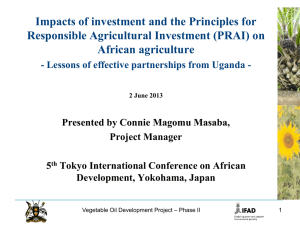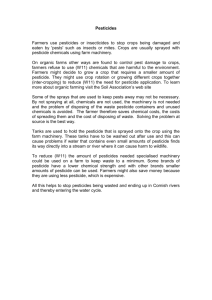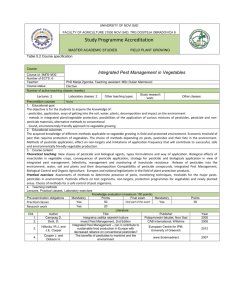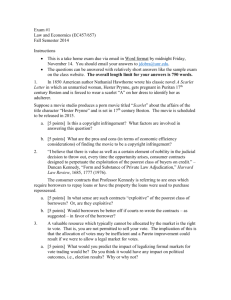Surge of high-input vegetable production in northern Thailand
advertisement
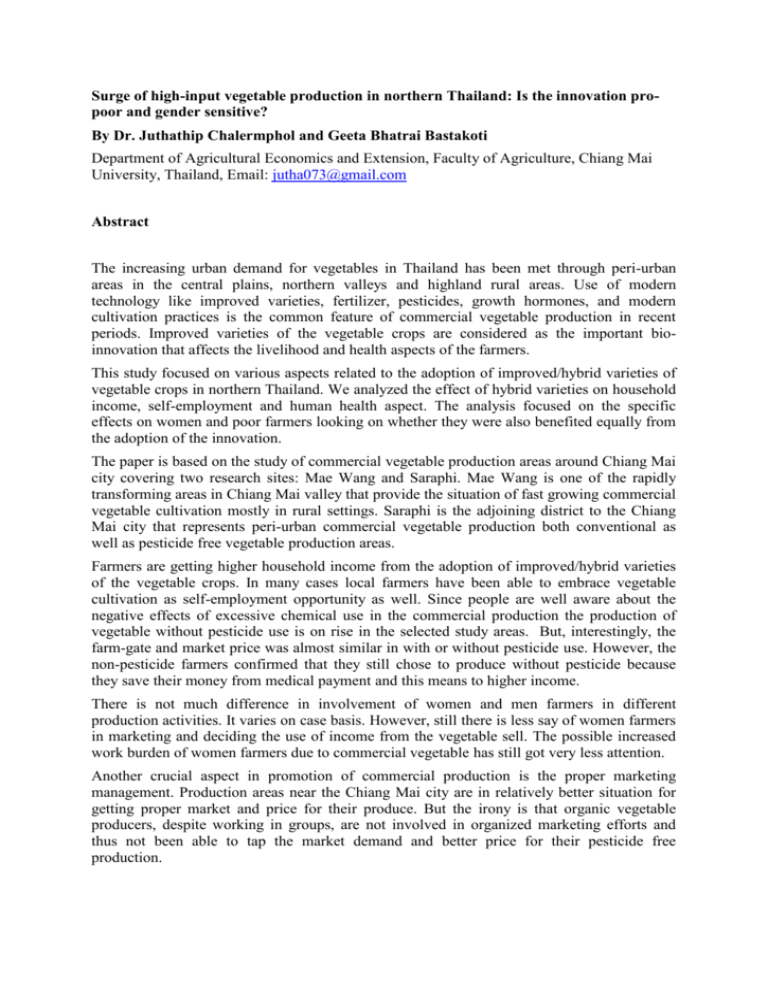
Surge of high-input vegetable production in northern Thailand: Is the innovation propoor and gender sensitive? By Dr. Juthathip Chalermphol and Geeta Bhatrai Bastakoti Department of Agricultural Economics and Extension, Faculty of Agriculture, Chiang Mai University, Thailand, Email: jutha073@gmail.com Abstract The increasing urban demand for vegetables in Thailand has been met through peri-urban areas in the central plains, northern valleys and highland rural areas. Use of modern technology like improved varieties, fertilizer, pesticides, growth hormones, and modern cultivation practices is the common feature of commercial vegetable production in recent periods. Improved varieties of the vegetable crops are considered as the important bioinnovation that affects the livelihood and health aspects of the farmers. This study focused on various aspects related to the adoption of improved/hybrid varieties of vegetable crops in northern Thailand. We analyzed the effect of hybrid varieties on household income, self-employment and human health aspect. The analysis focused on the specific effects on women and poor farmers looking on whether they were also benefited equally from the adoption of the innovation. The paper is based on the study of commercial vegetable production areas around Chiang Mai city covering two research sites: Mae Wang and Saraphi. Mae Wang is one of the rapidly transforming areas in Chiang Mai valley that provide the situation of fast growing commercial vegetable cultivation mostly in rural settings. Saraphi is the adjoining district to the Chiang Mai city that represents peri-urban commercial vegetable production both conventional as well as pesticide free vegetable production areas. Farmers are getting higher household income from the adoption of improved/hybrid varieties of the vegetable crops. In many cases local farmers have been able to embrace vegetable cultivation as self-employment opportunity as well. Since people are well aware about the negative effects of excessive chemical use in the commercial production the production of vegetable without pesticide use is on rise in the selected study areas. But, interestingly, the farm-gate and market price was almost similar in with or without pesticide use. However, the non-pesticide farmers confirmed that they still chose to produce without pesticide because they save their money from medical payment and this means to higher income. There is not much difference in involvement of women and men farmers in different production activities. It varies on case basis. However, still there is less say of women farmers in marketing and deciding the use of income from the vegetable sell. The possible increased work burden of women farmers due to commercial vegetable has still got very less attention. Another crucial aspect in promotion of commercial production is the proper marketing management. Production areas near the Chiang Mai city are in relatively better situation for getting proper market and price for their produce. But the irony is that organic vegetable producers, despite working in groups, are not involved in organized marketing efforts and thus not been able to tap the market demand and better price for their pesticide free production. Introduction In South-East Asian countries the agriculture has shifted from traditional rice cultivation to more diversified and market-oriented crop cultivation. Staple crops are becoming less important (Dawe, 2007). At the same time the demand for vegetables have increased sharply in many parts of the Asia including Thailand (Midmore and Jansen, 2003). In the recent decades, Thai agriculture overall has seen important transformations. In the central plains, the people growing non-rice crops have increased significantly in the recent decades (Isvilanonda et al., 2000). Similarly, Molle et al. (1998) reported significant changes in land and water uses in the central plain specially the shift from sugar cane to various cash crops such as baby corn, and also field crops, vegetables and fruit. This research focused on the northern Thailand that is even more dynamic compared to other regions of the country. In the northern region of Thailand the total area of land holding was around 25 million rais in 2003 which is around 7.7% increase from the year 1998. Similarly, looking on the total land holding by the land use during the period of 1993-2003, there has been decline in rice area with the corresponding increase in permanent crops (specially Longan orchard) and vegetable and ornamental plants (National Statistics Office, 2003). Among the provinces in northern region, Chiang Mai has the largest area under vegetable and flowers that is increasing gradually over the periods. In fact it has the highest area under vegetable crops among the provinces in the country. In the past the wet-season rice cultivation was common practice in the northern part of the country though some vegetables and semi-commercial crops were parts of the farming system. The transformation from rice-based farming to fruits and other permanent crops, and vegetable and ornamental plants are evident in the region including the Chiang Mai province (Shivakoti and Bastakoti, 2006). The commercialization of the agriculture is taking place at faster rates in the Chiang Mai valley (Cohen and Pearson, 1998; Rigg and Nattapoolwat, 2001; Habermann, 2003) and surrounding upland areas (Walker, 2003). Due to the increased market opportunity the contract farming [for orchard, vegetables and ornamental crops] was also in rise in the Chiang Mai valley area (Shivakoti and Bastakoti, 2006). The diversification was facilitated by economic changes including marketing facilities. Crop diversification was mostly the economic response to the decreasing profitability of “traditional” crops. The commercialization, specially the increased vegetable cultivation, has enhanced by the use of modern agricultural technologies. The farmers are replacing their traditional crop cultivars with the new innovations; the improved varieties, in many cases with the hybrid varieties. The improved varieties, including the hybrid, provide higher economic return due to their higher production potential and thus provide better livelihood opportunities. But it is not always that high input agriculture result into improved quality of life especially for the poor small farmers in Thailand (Eisses and Chaikam, 2002). In order to better understand the real impact of bio-innovation it is necessary to explore the intra-household impact of modern agricultural technology from gender perspective (Naved, 2000). In some cases, with the involvement in commercial vegetable production women farmers are able to improve their livelihood (Adhikari, 2008). But in other cases it was not clear whether the benefit from commercialization was realized by women and poor farmers. We can also relate it to the gender dimension of land holding in northern Thailand; there is overall decline (1993-2003) in the land holding by female (National Statistics Office, 2003). Similarly, the innovations sometimes come with negative externalities, specially the negative effect in human health in this case. For example, besides providing higher production, the improved varieties are mostly the high-input responsive (Mundalak et al., 2004). Thus it is seen that with the changing land use in the form of commercial vegetable, per unit use of inorganic fertilizer and pesticide has also increased (National Statistics Office, 2003) in the Chiang Mai valley. The pesticides are used to control pests, but at the same time the farmers are often exposed to pesticides through skin contact, breathing and swallowing (IPM DANIDA, 2003). Recently with the growing awareness about the negative effect of pesticide use, and increased willingness of consumers to pay for pesticide free vegetable (Posri et al., 2006) we can see that pesticide free production is increasing (Habermann, 2003). But still the improper training in the use of pesticides and ineffective regulatory system has resulted into the health risk from the pesticide use (Eisses and Chaikam, 2002). It is noted that only few farmers take sufficient precaution during pesticide application (Danida, 2005; Chalermphol and Shivakoti, 2009). Thailand is going through rapid industrialization process and economic growth; however the agriculture still contributes significantly in the Thai economy (Thaiprasert, 2004). Along with economic transition, in recent decades Thai agriculture has experienced significant transformations (Shivakoti and Bastakoti, 2006). Statement of the problem Thailand is going through rapid industrialization process and economic growth; however the agriculture still contributes significantly in the Thai economy (Thaiprasert, 2004). Along with economic transition, in recent decades Thai agriculture has experienced significant transformations (Shivakoti and Bastakoti, 2006). Similarly, the demand for vegetables has increased in many parts of the Asia including Thailand (Midmore and Jansen, 2003). The increasing urban demand for vegetables in Thailand has been met through peri-urban areas in the central plains, northern valleys and highland rural areas. Such an ever-increasing demand has also stimulated the innovations that contribute to the increased production and quality of the vegetable crops. Use of modern technology like improved varieties, fertilizer, pesticides, growth hormones, and modern cultivation practices is the common feature of commercial vegetable production in recent periods. The trend of using improved varieties, mostly hybrids, has increased substantially. Most of the hybrid varieties are high input responsive compared to local varieties (Mundlak et al., 2004). This improved seed system and hybrid varieties as end product of the innovation technology in the agriculture are used by many farmers to increase the production. The bio-innovation process for the agricultural boost is supported by various agencies, government to private research centers, commercial firms including seed companies, and local informal networks like traders and seed agents. With this context, the proposed research focuses on various aspects related to the adoption of improved/hybrid varieties of vegetable crops in northern Thailand. In technological front it represents the research domain reflected by the improved varieties either through selection or breeding. One study in Thailand noted that hybrid varieties have helped increase income and provided self employment to the farmers (Bastakoti, 2009). But it was not clear whether women and poor farmers were also benefited equally from the adoption of the innovation. Another point to note here is that hybrid vegetable production is high-input venture including the use of heavy amount of pesticides. The rural farmers including women are more exposed to the hazardous pesticide causing negative effect to their health as they do not well follow the safety measures. Some studies conducted in the Chiang Mai provinces including vegetables and fruits have clearly documented that only few farmers take sufficient precaution during pesticide application (Danida, 2005; Chalermphol and Shivakoti, 2009). Similarly, with the advancement in technological aspects various informal networks have emerged such as; local agents and traders, producers’ group etc which is important social capital and represent institutional context. It also represents enterprise domain [represented by traders] and interaction among framers-traders-users [demand domain]. Clear understanding of their role in the process of bio-innovation and adoption is important (Bastakoti, 2009). Research Objectives In this research we will look on the gender dimensions of the varietal adoption in vegetable production including livelihood and health effect on poorer section of the society. Improved varieties [including hybrids] of the vegetable crops are considered as the important bioinnovation that affecting the livelihood and health aspects of the farmers. The proposed research will try to address the following objectives: To identify the factors affecting the adoption of improved varieties of the vegetable crops, with special focus on the access of poor and women farmers towards this technology To examine the intra-household impact of improved vegetable varieties looking on livelihood impact on women and changing gender roles To examine the effect of commercial vegetable production on health of both women and men farmers To assess the roles of various formal and informal networks on commercial vegetable technology development, dissemination and market and demand management of the vegetable products Research Plan and Methods This study focused on various aspects related to the adoption of improved/hybrid varieties of vegetable crops in northern Thailand. It also analyzed the effect of hybrid varieties on household income, self-employment and human health aspect. The analysis focused on the specific effects on women and poor farmers looking on whether they were also benefited equally from the adoption of the innovation. The paper is based on the study of commercial vegetable production areas around Chiang Mai city covering two research sites: Mae Wang and Saraphi. Mae Wang is one of the rapidly transforming areas in Chiang Mai valley. This district covers both hilly areas and foothill plains. This site will provide the situation of fast growing commercial vegetable cultivation mostly in rural settings. Saraphi district is the adjoining district to the Chiang Mai city that represents peri-urban commercial vegetable production both conventional as well as pesticide free vegetable production areas. The information was collected from both primary and secondary sources. The secondary sources presented documents from selected TAOs, District Agriculture Offices, Provincial office, published reports and literatures. This included contacting with Seed Company and their representatives. Secondary sources basically provided information on the trend of vegetable production in the province and selected study districts and sub-district including the introduction of improved/hybrid varieties of selected vegetables crops. The primary information came from the vegetable growers of the selected areas. The primary collected included vegetable production areas, variety used, input use, labor use, mobility, pesticide use, health related issues and farmers perception on various aspects. In addition, in each study areas some local agents were interviewed. After focus group discussions, household survey will be conducted with selected producer farmers. It aims to assess the impact of adopting bio-innovation in their cultivations. At this stage, the study of pesticide usage and health impacts from using pesticides will consider to the chemical pesticides belonging to WHO toxicity class Ia (extremely hazardous) and Ib (highly hazardous). Results Saraphi and Mae Wang district has 4 and 2 years of experience respectively in growing vegetable without pesticide use. Interestingly the farm-gate and market price was almost similar in with or without pesticide use. Initial result shows that most of the vegetable farming activities are done jointly by men and women farmers. Organic producers are working in groups. Most of the vegetable producing farmers were between 31- 40 years. From the study, farmers were getting higher household income from the adoption of improved/hybrid varieties of the vegetable crops. In many cases local farmers had been able to embrace vegetable cultivation as self-employment opportunity as well. Since people were well aware about the negative effects of excessive chemical use in the commercial production, the production of vegetable without pesticide use was on rise in the selected study areas. But, interestingly, the farm-gate and market price was almost similar in with or without pesticide use. However, the non-pesticide farmers confirmed that they still chose to produce without pesticide because they saved their money from medical payment and this means to higher income. Farmers sold their vegetables by two ways. First was the sale of traditional products that require dealers to buy in the area. Another way was the sale of products in the organic vegetable market which was provided by Director of Technology Training Center in San Sai sub-district, together with Saraphi district. Then the farmers could sell their farm products within the Office District. Another channel was placing as consignment at Multiple Cropping Center (MCC) in Chiangmai University. The sale at the store in the Lamphun market; Chatuchak Lamphun, was another active sale way. Because there were some friends and relatives of farmers which already attended the selling group, the farmers trusted to start joining. This also improved the farmers’ market management skills and they did not wait for merchants. In addition, Saraphi district together with Agriculture District, Chiang Mai Public Health, Chiang Mai Rajabhat University, Mae Jo University and Chiang Mai University jointly promoted the project of producing organic vegetables in the area along the rail on a main road by the villagers in the district. Production had been sold near by the rail and train station. They were located on the side rail road. Kinds of distributed vegetables were coriander, green chilli, morning glory, lettuce canton, Chinese cabbage, vocational spinach, heart cauliflower and emperor lettuce. It was found that morning glory and vocational spinach entered volume production overflow. At the beginning of selling, they sold together with different groups in general market. Then they brought local organic vegetables in season to distribute in order to add diversity to the types of vegetables including which were coriander, ivy gourd, tiger herbal, Cha-om, jackfruit, Ceylon spinach, Alpinia galangal, lemongrass, turmeric, sapodilla, green chilli, lemon, banana blossom, pumpkin shoot, basil, thyme and curry set. The opinions of farmers in economic conditions of families and communities to grow organic vegetables as a career are enough income to expenditure (97.50%), pricing itself without going through middlemen (95.12%), certain market (92.74%), revenue increases and reduced expenditure on agriculture (90.36%), reduce production costs from the use of more expensive chemicals (83.21%), add employment in the community (82.10%), result in extra income (11.78%), and only 2.74 % of the opinion that there is more revenue but not enough to charge. The opinions of farmers in the social and well-being are eating organic vegetable (100%), healthier (95.32%), safe from reduce using pesticides (82.45%), the members of the community are. unity (71.67%), community dependence (66.20%), the members join production and marketing planning (47.24%). From the interview with Chairman of the group of organic vegetables farmers found that organic vegetables have been very helpful in terms of health, economic and social because organic vegetable farming reduce the risk of exposure. In addition, care must be made with more vegetable activities between family members. Children can help parents to work. Parents do not have to go find a job outside the home or in the city. This is also reducing social problem. Moreover, growing organic vegetables help to generate income for farmers compared to rice and longan cultivation. The price of organic vegetables tend to be higher and regular supply of purchase in certain markets. In this study, all farmers were asked to provide opinions on harmful effects of pesticide use in the part of health impacts and environmental issues. More than half (54.1%) responded that pesticides did not affect much but it could affect human health in long term (67.3%). Farmers reported that they sometimes had headache, dizziness, fatigue, skin itching, burning sensation in nose, runny nose, cough, dry throat and difficulty in breathing. They also experienced in eye itching or burning pain during spraying and skin itching during mixing and spraying pesticides but they believed that these symptoms were common occupational illness and could be occurred even among healthy person (61.8%). The majority (61.1%) thought pesticide poisoning was not a serious illness. It could not be the cause of abortion or affect nervous system. From their experiences, pesticides poisoning could be the cause of death (16.6%) only in case of suicide. In relation to the farmers who normally used pesticide, sprays were repeated at weekly or on a regular calendar schedule. They sprayed pesticides as a preventive measure, before there was any visible damage to crops by pests instead of wait until a certain pest had been identified. Frequency of spraying ranges was scheduled by themselves from once every three to once every five days, which was excessive by any agricultural standard. Discussion and conclusions Farmers are getting higher household income from the adoption of improved/hybrid varieties of the vegetable crops. In many cases local farmers have been able to embrace vegetable cultivation as self-employment opportunity as well. The vegetable farmers had avoided protecting themselves against pesticides and reducing their exposure to chemicals although they knew about pesticide prevention practices. They understood almost all of instructions from the guidelines but they considered first about cost and convenience. Farmers who grew vegetables with pesticide using strongly believed that pests were significant problems and had to be removed as indicated by the high belief indices. There was not much difference in involvement of women and men farmers in different production activities. It varied on case basis. However, still there was less say of women farmers in marketing and deciding the use of income from the vegetable sell. The possible increased work burden of women farmers due to commercial vegetable had still got very less attention. Another crucial aspect in promotion of commercial production was the proper marketing management. Production areas near the Chiang Mai city were in relatively better situation for getting proper market and price for their produce. But the irony was that organic vegetable producers, despite working in groups, were not involved in organized marketing efforts and thus not been able to tap the market demand and better price for their pesticide free production. References Adhikari, R. 2008. Economic Dimension of Empowerment: Effects of Commercialization and Feminization of Vegetable Farming on Social Status of women in an Urban Fringe of Western Nepal. Himalayan Journal of Sociology & Anthropology, 3: 86-105. Bastakoti, R. C. 2009. Impact of improved vegetable farming technology on farmers’ livelihoods: A case of selected vegetable crops in Thailand. Acta Horticulturae, 809: 91-100. Chalermphol, J., and G. P. Shivakoti. 2009. Pesticide use and prevention practices of Tangerine growers in Northern Thailand. Journal of Agricultural Education and Extension, 15 (1): 5-22. Cohen, P. T., & Pearson, R. E. 1998. Communal irrigation, state, and capital in the Chiang Mai Valley (Northern Thailand): Twentieth-Century transformations, Journal of Southeast Asian Studies, 29(1), pp. 86-110. DANIDA. 2005. Pesticides-Health survey: Data of 109 farmers in Chaiprakarn, Chiang Mai, Thailand. Danish International Development Assistance. Dawe, D. 2007. Key trends affecting agriculture water resources management in Southeast Asia. In FAO (2007): The future of large rice-based irrigation systems in Southeast Asia. Proceedings of the regional workshop on the future of large rice-based irrigation systems in Southeast Asia, Ho Chi Minh City, Viet Nam26–28 October 2005. Bangkok: FAO. Eisses, R., and J. Chaikam. 2002. Organic farming and gender roles in Northern Thailand. LEISA: 26-27. Habermann, B. 2003. Local Agro-Ecological Knowledge in Peri-urban Vegetable Farming Systems, Chiang Mai, Northern Thailand. M Sc Thesis. Bangor: University of Wales. IPM DANIDA. 2003. Did you take your poison today? IPM DANIDA: Strengthening Farmers’ IPM in Pesticide-Intensive Areas, Bangkok, Thailand. Isvilanonda, S., Ahmad, A. & Hossain, M. 2000. Recent changes in Thailand’s rural economy: evidence from six villages. Economic and Political Weekly, Vol. XXXV, Nos. 52 and 53, December. Midmore, D. J., and G. P. Jansen. 2003. Supplying vegetables to Asian cities: Is there a case for peri-urban production? Food Policy, 28(1):13-27. Molle, F., C. Chompadist, and P. Sopaphun. 1998. Beyond the farm-turn-out: on-farm development dynamics in the Kamphaengsaen irrigation project, Thailand. Irrigation and Drainage Systems, 12: 341–358. Mundlak, Y., D. Larson, and R. Butzer. 2004. Agricultural dynamics in Thailand, Indonesia and the Philippines. Aus. J. Agric. Res. Econ., 48(1): 95–126. National Statistics Office. 2003. 2003 Agricultural Census Northern Region. National Statistics Office/ Ministry of Information and Communication Technology, Thailand. Naved, R.T. 2000. Intra-household impact of the transfer of modern agricultural technology: A gender perspective. IFPRI FCND DP No. 85. Washington, D.C.: International Food Policy Research Institute. Posri, W., B. Shankar, and S. Chadbunchachai. 2006. Consumer attitudes towards and wiilingness to pay for pesticide residue limit compliant “Safe” vegetables in Northeast Thailand. Journal of International Food and Agribusiness Marketing, 19(1): 81-101. Rigg, J., and S. Nattapoolwat. 2001. Embracing the Global in Thailand: Activism and Pragmatism in an Era of Deagrarianization. World Development, 29:945-960 Shivakoti, G. P. and R. C. Bastakoti. 2006. The robustness of Montane irrigation systems of Thailand in a dynamic human-water resources interface. J. Inst. Econ., 2 (2): 227-247. Thaiprasert, N. 2004. Rethinking the role of the agricultural sector in the Thai economy and its income distribution: A SAM analysis. Forum Int. Dev. Stud., 27 (8):187-212. Walker, A. 2003. Agricultural transformation and the politics of hydrology in Northern Thailand. Development and Change, 34 (5): 941-964.


